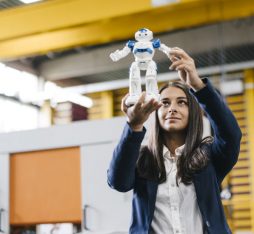The widespread use of connected objects that can capture data (e.g. temperature, humidity) and perform actions on equipment (e.g. opening gates, turning on lights, closing shutters) has led to the integration of previously closed applications within complex systems such as buildings, thereby turning them, quite literally, into smart buildings. The same ideas apply to other environments or systems on a larger scale, such as energy networks or cities. However, buildings bring together all of the challenges that we must overcome for the future of the Internet of Things, and, more broadly, for the future of cyber-physical systems representing the integration of IoT into industrial automation systems. There are two key aspects to these challenges: technical management and operational management.
Efficient and comprehensive technical building management factors in all of a building’s existing specialised objects, equipment and technical systems, even if their digital capabilities are not state-of-the-art. A building may be equipped with connected objects, but we also need to manage the greater number of unconnected objects that make up the building, such as rooms, technical systems and furniture. To achieve this, we must keep a comprehensive representation of the building, virtually merging the digital and physical worlds so that they can interact more effectively and on a larger scale.
Operational building management requires several business areas to collaborate, for example those involved in energy management, logistics/maintenance or services for user comfort. Operational building management is currently not as efficient as it could be because each technical team uses its own BMS (Building Management System) independently. Teams work in their own separate “silos”, with expertise in one particular area but with poor knowledge of and little to no interaction with the other areas. These silos need to be opened up so that teams can collaborate better and with greater operational efficiency.
Bridging physical and digital infrastructures
Thing’in is an Orange-initiated integrative research platform for the Web of Things – viewed as the future of the Internet of Things, supporting a shared representation of physical and digital infrastructures. “Thing’in” allows us to address these two challenges – operational and technical building management – by offering an innovative approach in comparison with current IoT platforms such as Microsoft Azure, AWS IoT from Amazon and Orange Live Objects. These platforms are limited to collecting, storing and managing data generated by connected objects, i.e. the small subset of the building’s equipment that is already part of digital infrastructures.
Thing’in allows physical and digital infrastructures to become integrated on the basis of a comprehensive description of the building’s environment. It describes physical objects, connected and unconnected, together with all of their properties and, if relevant, their current state. Crucially, the platform uses a graph to describe how these objects relate to their environment and with other objects. In this way, Thing’in is akin to some new kind of “social network of objects”. For a room in a building, for example, Thing’in allows us to describe the room itself, the objects inside and the relationships between these objects. There are several types of object relationships, for example a chair can be inside the room, or the presence sensor can be set to trigger an action from the connected lamp if the sensor detects a presence in the room.
This means we can have the full description of the building’s physical infrastructure with Thing’in, while its digital infrastructure is managed with current IoT platforms such as OM2M or Orange Live Objects. We need to make it easier to link the two. An object description in Thing’in may contain information called access modality in order to support this. It contains the technical chain that allows to interact with the real object through its operational platform.
Opening up IoT silos
Now that descriptions of the building and its objects are part of the “Thing’in” social network of things, it is easier to open up existing silos and share data between various technical teams, while meeting security and confidentiality requirements by carefully managing data access rights. In addition, some objects in the building will be of interest to several business areas and each area will want to view the object with its own data. For example, a lamp is of interest to our three technical teams: energy management, logistics / maintenance, and user comfort services. Thing’in allows the lamp to be described in accordance with how each of these teams view the object: data on energy consumption and power for the energy experts; status and location for logistics/maintenance; and service features (turn on, turn off, colour management) for user comfort services. Lastly, this data sharing can go one step further by sharing the objects themselves. For example, a presence sensor is useful in terms of energy management as energy-consuming devices can be turned on and off depending on whether anyone is present. It is also useful for logistics/maintenance teams to determine which areas of the building are used most and therefore need checking more often for proactive maintenance purposes.
Technical teams can use specialist interfaces based on the BIM (building information model) to share the federated view of the building built using Thing’in. This is used to create a digital twin, a digital representation of a physical object that is continuously updated along with the object’s evolving status thanks to the integration of data from various platforms: Thing’in, for describing physical objects and their relationships, and underlying technical platforms, for collecting data from connected technical systems that equip the building.
Open and collaborative innovation
These various concepts have been demonstrated as part of a collaboration between Orange Research and several partners within the Thing’in ecosystem: the French Scientific and Technical Centre for Building (Centre Scientifique et Technique du Bâtiment – CSTB), the CRNS Laboratory for Analysis and Architecture of Systems (Laboratoire d’Analyse d’Architectures des Systèmes du CNRS – LAAS-CNRS), the Computer Science Research Institute (Institut de Recherche en Informatique – IRIT) and the startup WiseBIM.
This collaboration provided an opportunity for partners to work together on several research challenges related to managing a smart building and its environment.
Digitising the real world
A Building Information Model (BIM) provides a digital, perfectly structured and semantic representation of a building or, more generally, a neighbourhood or city (see the concept of a multi-scale BIM below).
To create a BIM of a building, we first have to think about the building’s design and construction phases. The methodologies used in these phases can now be used by architects, design consultants and companies to create this digital twin as the work progresses. However, real estate does not just consist of new buildings; it primarily comprises existing buildings, which may be renovated. The BIM digitisation process for existing buildings is therefore vital for getting the most out of this new technology.
WiseBIM is an innovative startup that helps property portfolio managers to digitise their property stock into BIM. WiseBIM’s AI-based solution allows 3D BIMs to be generated from existing architectural plans, offering a digitisation process that is ten times faster than conventional methods.
Connected objects and their environment are closely linked. It is especially necessary to know the precise location of these objects within the building, firstly to interpret the data obtained from the object (particularly sensors), and secondly to optimise the decision-making process when activating and using these objects.
Existing buildings therefore need to be digitised before they can be made “smart”. Creating BIMs is the preferred way to do this as it allows unstructured data (e.g. 2D architectural plans, point clouds, 3D images) to be transformed into structured data. This means you can locate the data in absolute or relative terms using the hierarchy of spaces and parts within the building. The BIM integrates a database that firstly consolidates the description of the building envelope and the virtual segmentation of the building into floors and spaces.
BIMs can be automatically generated using existing stock (e.g. WiseBIM solution) or manually generated using BIM editing software.
Beyond its application with connected objects, the transformation of existing building stock into BIMs is part of the digital transition in real estate and construction, particularly for asset management requirements or for renovation and demolition.
Enhancing structured and unstructured data: moving from building digitisation to enhanced digitisation
LAAS-CNRS is a research laboratory at the CNRS. Its research aims to gain a fundamental understanding of complex systems while considering how they could be used. In this context, the SARA team works on networks, next-generation communication systems, the Internet of Things and their applications.
IRIT is a joint research unit focused on researching data and computational sciences. The MELODI team focuses on research that links natural language analysis and formalisation with knowledge representation and modelling.
Building data inventory or collection and storage systems generally comprise raw data that is mostly limited to precise terms and values that refer to fixed or dynamic properties. The challenge is to switch from this type of stored data, mostly kept in various systems that are often in silos, to an interlaced and comprehensive view of all the data and objects in a complex system. The solution proposed as part of the collaboration was to help clarify the meaning of this data and to map the data via semantisation. This process uses models that subsequently allow complex queries to be submitted and inferences to be made using data reasoning mechanisms. This allows semantic digitisation to offer more comprehensive uses for the building data. Ontologies – models around which semantisation is centred – provide formal and clear specifications for conceptualisation. To do so, they represent concepts, relationships, logical axioms and units. Transforming raw data into semantic data requires a mechanism for enriching the data by adding descriptions based on ontological elements. Our proposed solution facilitates this process as it can either be carried out automatically or in collaboration with a system’s manager.
Multi-scale management, from building management to land management
CSTB (Scientific and Technical Centre for Building) is a public institution for industry and business which aims to support stakeholders with their innovations and projects. More specifically, CSTB aims to support the industry in its digital transition towards BIM, including its uses and tools, by focusing on the use of openBIM standards (IFC, CityGML). CSTB is developing software solutions to visualise, manage, share and interface multi-scale BIMs – eveBIM – with operating tools for building and city scales.
Multi-scale BIM makes digital model designs scalable to all built environment sizes and dimensions, including land, cities, neighbourhoods, buildings and infrastructures. For these various scales, international organisations such as OGC (land and city scale with CityGML) and BuildingSmart (building and infrastructure scale with IFCs), provide open standards for describing digital models. Major publishers of GIS (geographical information system) and CAD software for buildings now take these standards into account in their software. Multi-scale BIM allows these various dimensions to be dovetailed, extending management capabilities to environments around the buildings. Each dimension has operators, including politicians, citizens and residents, developers, builders and suppliers of products and equipment for buildings or cities.
Conclusion and main takeaways
With Thing’in, Orange graph-based Web of Things platform, we can provide solutions to two future challenges arising from the Internet of Things: describing whole environments in which applications operate, and improving collaboration and data sharing between IoT stakeholders by opening up existing silos. Thing’in can also be used to federate current IoT platforms with features that are compatible with this type of platform. Thing’in actually goes one step further by describing the context of connected and unconnected objects, as well as the interactions between these objects (relationships). We used smart buildings as an example here, but this is a multi-scale approach that can be applied to smaller (e.g. a home) or larger (e.g. a city) dimensions.











